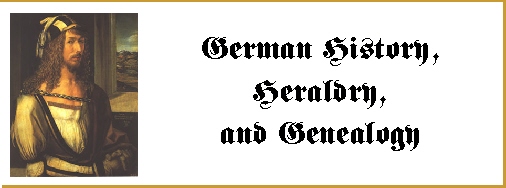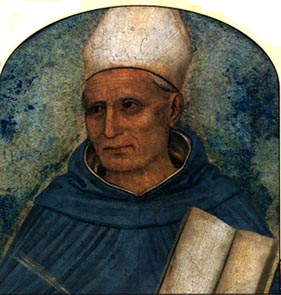

St Albertus Magnus (Albertus de Groot)
Written and researched by Margaret Odrowaz-Sypniewska

FEAST DAY AND PATRONAGE:
St. Albert's feast day is November 15th, he was a famous philosopher and scientist. He is the patron saint of medical technicians and students of natural sciences. He was known for his scientific curiousity and disproved some of the accepted beliefs of the day. One such theory was that birds were created from trees and nourished by the sap. Albert proved that birds were hatched from eggs laid by their mothers, and that birds were nurtured in nests by their parents until they learned how to fly. These conclusions were made from observations.
EARLY LIFE:
Albert was born between 1193 and 1207 in a castle Lauringen, Swabia, on the Danube River, near the city of Ulm. He was the eldest son of a Knight known as Count Bollstadt. He was said to have been tutored by Blessed Jordon of Saxony/Sachsen (S. Germany), who inspired him to join the Order of Preachers.
EARLY STUDIES IN ALCHEMY:
Albert studied alchemy. At this time alchemy was primarily concerned with changing base metals into gold. The reason for this concept was the lust of kings and prelates for wealth. There was also the belief in the mythical Philosopher's Stone and the Elixir of Life. Many believed that this elixir would ensure perpetual life and health (Maple, 79).
Alchemy, in the middle of the 12th century, began with the study of Arabic manuscripts. The first translation was made by Robert of Chester in 1144. We can surmise that Albert may have begun to study these works as a youth. It was Alberto Magnus and his contemporary, Roger Bacon, who began to investigate this text and those of the Arabic world. St. Albert's studies were made mostly through the work of Avicenna. Avicenna (980-1037) studied alchemy but disclaims that neither he or anyone else could make gold.
St. Albert's most famous work De rubus Metallicis et Mineralibus in 1214, helped spread the facts and theories of alchemy across Europe. He was both a student and teacher of alchemy and chemistry in his adulthood.
Albert the Great was one of the alchemists reputed to have succeeded in discovering the Philosopher's Stone. The Philosopher's stone, by theory, would serve as a catalyst to transform metals and other raw material into gold. It was not necessarily an actual stone, but it might have been a combination of fire and water, or other unlikely mixtures. However, now we know that this was mere superstition.
|
ASTROLOGY: St. Albert Magnus and St. Thomas Aquinas (1225-1274) both supported non-determininstic astrology. Albert thought that the stars and planets were media acting between higher intelligence and this world. In other words he believed that there might be worlds other than earth. Worlds that might have a higher knowledge of life.
MAGICAL REPUTATION: Albert Magnus was called the greatest magician of his time. The Middle Ages took a rather grim view of magic and the occult, even though many believed in their ability to promote good luck. Occult meant hidden, and the occult world had to be careful not to attract too much attention.
He had many royal consultants, including Prince William of Holland. Albert was also thought to be a magician, since he was repeatedly charged, by some of his unfriendly contemporaries, with holding communications with the devil, practicing the craft of magic, and with the making of a demonic automation able to speak. This "demonic automation" refers to a mechanical man who could answer difficult questions. The robot was said to chat on and on and was destroyed by Thomas Aquinas, Albert's pupil, because it disturbed his train of thought.
Albert believed in the existence of the incubi and succubi demons.
ALBERT'S EDUCATION AND RELIGIOUS LIFE:
Albert read many interesting theories in his life and studied them in great depth. Albert took his studies at the University of Padua and became a Dominican, despite his parent's opposition, in 1222/3 (at age 22), and some say he was 22 years old at this time. In Padua, Albert heard the Master General of the Dominicians, Blessed Jordon of Saxony, preach. Jordon was said to be a great orator and Albert was touched by his words. By 1228 Albertus was teaching in Hildesheim, Freiburg im Breisgau, Regensburg, and Strasbourg.
At one point Albert considered leaving the Dominicans, however the Virgin Mary appeared to him in a dream and she said she would intercede for him, so Albert could obtain divine wisdom. Albert kept to the Order and taught for the next twenty years in six major cities.
In 1243-1244 Albert was the magister at the Paris theology faculty. He earned his doctorate at the University of Paris in 1245. In Paris Albert taught philosophy. It was his colleagues that first referred to him as "Albertus Magnus" (Albert the Great) and doctor universalis (the universal teacher). However, the term Magnus is not the result of his reputation, but is the Latin equivalent of his family name, de Groot.
Albert studied the work of Plato and Aristotle, and later the works of the Neoplatonists. In 1245, Albert wrote: Tractatus de Natura Boni Summa Theologica - on the Ethics of Aristotle and Aristotle's teachings of the natural sciences. This book was an encyclopedia of human knowledge that included discussions of logic, rhetoric, mathematics, astronomy, economics, politics, ethics, and metaphysics. Aristotle's theory was that there was a prime matter that was the basis of all substances. Albert challenged some of Aristotle's statements from
what Albert had observed through his own study of science.
Albert firmly believed in the benefits of botany claiming various plants, rocks, and amethysts improved clairvoyance. Albert collected specimens and drawings of insects, plants, and trees. He wrote books on botany, astronomy, physics, mineralogy, and chemistry. In one of his geography books he taught how latitude affects our climate. He went on a whale hunt in Friesland and saw Greenland whales for the first time. Albert loved animals and had a falcon which he used for one of his hobbies which was falconry.
From 1248-1254 Albert was in Cologne, Germany. He founded the University of Cologne. He taught philosophy, and he was considered one of the most famous philosophers of his day. In Cologne, Albert served as director of regional studies. He taught St. Thomas Aquinas here, and in 1254 he was made Dominican Provincial of Germany, after his former bishop was removed from the office. Albert found the ex-Bishop's monks to be undisciplined and quit after two years. It seems that there was a lot of drinking and other debauchery in their numbers. Albert felt that he was wasting his time there since the tenor was already set and he could not cure their problems overnight. He thought his own talents could be put to better use.
By 1260-1262 Albert was the Bishop of Regensburg/Ratisbon. From 1264-1266 he was Bishop of Wurzburg. Then he was bishop of Strasbourg (1268) and Cologne (1270).
In 1245, Albert wrote: Tractatus de Natura Boni Summa Theologica - on the Ethics of Aristotle.
Pope John XXII, 1317
LEGENDS SURROUNDING ALBERT MAGNUS:
With his knowledge of magic, Albert was said to have helped abduct a king's daughter from France. He was said to have a magic cup for curing the sick, and was reputed in have conjured up snakes in St. Peter's.
ALBERT MAGNUS'S BOOKS:
Albert collected and wrote over forty volumes of books.
ALBERT MAGNUS'S FAILING HEALTH AND DEATH:
In 1278, Albert was delivering a lecture when his memory failed him. This was thought to be the onset of dementia. His last two years of his own life were cloudy, because Albert spent his last years as a hermit. By 1280 his memory got much worse and he began to lose ground and his health failed. Albert died November 15, 1280 in Poland. His body was blessed by Bishop Siegfried of Westerburg. He was dressed in his large wooden chair dressed in his habit, while his Dominican brothers sang Salve Regina. He was buried at St. Andreas in Cologne, Germany. His cult site is at St. Andreas in Cologne and he is the patron saint of Cologne. Albert was beautified in 1622 and canonized in 1931.
Albert was a truly remarkable man.
***Saxony/Sachsen was a former state in Southern Germany.
***Regensburg is a city on the Danube River, Oberphaltz, Bayern (Bavaria), Germany.
SOURCES:
Bengtson, David. Past Lives of Famous People: Journeys of the Soul. Woodside, CA.: Bluestar Communications, 1997.
Biederman, Hans. Dictionary of Symbolism. New York: A Meridian Book, 1994.
Coln-Sherbok, Lavinia. Who's Who in Christianity. London: Routledge, 1998.
Craughwell, Tomas J. Saints For Every Occasion. Charlotte, N.C.: C.D. Stampley Enterprizes, Inc., 2001.
Crow, W.B. A Fascinating History of Witchcraft, Magic, & Occultism. Hollywood, CA.: Wiltshire Book Company, 1970.
Frese, S.F.O., Michael. Patron Saints. Huntington, Indiana: Our Sunday Visitor Publishing Division, 1992.
Koenig-Bricker, Woodeene. 365 Saints. San Francisco: HarperSanFrancisco, 1995.
Maple, Eric. The Domain of Devils. New York: A.S. Barnes and Co., Inc., 1966.
Medieval Wisdom. Alchemy: The Art of Knowing. San Francisco: Chronicle Books, 1994.
O'Dell, Catherine. Patron Saints. Ann Arbor, MI.: Servant Publications, 2001.
Water, Mark. A Year With the Saints. Liguori, Missouri: Ligouri Publications, 1997.
Wedeck, Harry E. A Treasury of Witchcraft. New York: Citadel Press, 1961.
The Theories of Magic in Medieval Times:
His Contemporaries:
MY OTHER SAINT SITES:
This page was last updated on April 27, 2007
